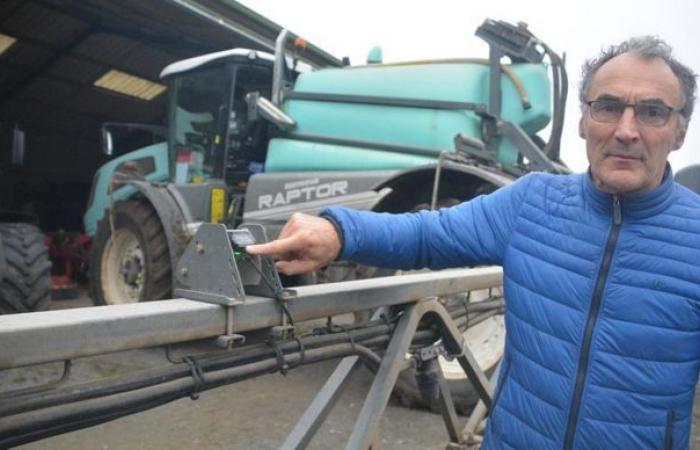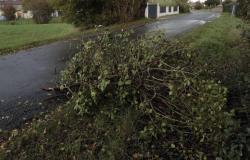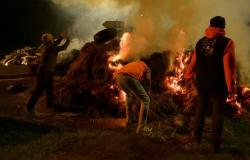Don't think that José Godineau is a gear enthusiast. “Holding the wheel of a machine doesn’t interest me, it has no interest.” You won't see him playing Farm simulator, he has better things to do. “Technique is only interesting if we start from agronomy,” professes the cereal grower from Saint-Macaire-du-Bois (Maine-et-Loire).
With his brother Tony, he is at the head of a 570 hectare farm, EARL du Brignon, but also a trading structure and an agricultural work company. What has driven him for the 34 years he has been here is finding solutions to respond to problems in order toimprove your practices.
From the beginning of the 90s, he installed the teleinflation on his tractor and his compost spreader to reduce the soil compaction. At the time, it was inspired by the Paris-Dakar vehicle system. He had DIYed it himself, with a refrigerator compressor in the tractor. “Today, no machine enters my plots at more than one bar of pressure,” argues the 56-year-old farmer.
In 1992, he manufactured a front hopper to put the grain reserve at the front and act as a counterweight. “Kuhn came to see me 5 or 6 years later, they then made their TF 702”. He has been working with research stations and manufacturers' design offices for thirty years. “Over time I have built up a network, and when I have an idea or a need, I can find answers to move forward.”
PWM nozzles, first stage of the rocket
This is how he was the first to test new technologies of spray with the Berthoud firm, first the PWM nozzles in 2017 (dose modulation), then the “ spot spraying » (localized spraying) two years later.
PWM, or Pulse width modulation, allows you to modulate the quantity of product sprayed without changing the spray pressure. This involves controlling the opening and closing of the nozzles at an extremely high frequency, ten to thirty times per second. By adjusting the opening and closing duration, the flow rate is controlled, which allows uniform application of the weedkiller, whatever the speed of advancement of the sprayer. No need to stay at a constant speed, the spray adapts and the coverage is uniform.
“Between 10 and 18 km/h, the pressure and flow do not change, the PWM nozzle compensates for the variation in flow to respect the liter per hectare and the pressure. If I reduce my speed, instead of reducing the pressure, the PWM lowers the flow rate” explains José Godineau. “For me the main advantage of PWM was to choose my operating pressure, that is to say the droplet size independently of my forward speed which varies between 10 and 18 km/h”, explains l farmer, who says to himself “ hyper demanding on the size of the droplets ».
Result of these pulsating nozzles on the EARL du Brignon plots: “A safe spray quality and a higher construction throughput ».
70% product savings
PWM was the prerequisite for moving towards localized spraying. From 2019, José Godineau is testing the prototype of this system developed jointly by Berthoud and the start-up Carbon bee. Eleven cameras (RGB, infrared and hyperspectral) are installed on its self-propelled machine, one at the front of the machine and ten along the thirty-meter ramp. Their job is to scan the vegetation.
Artificial intelligence identifies weeds, analyzes their size to only apply weedkiller to the weeds. For this to work, you need a stable ramp 50 cm high, but above all you need a plant recognitionand for this everything has to be built. Green on brown (plant on earth) is easy to identify. Green on green is more difficult, you need a very precise spectral signature. This is what Carbon bee is all about.
“At the beginning, we went on the bindweed and the chardonfor example, we had a specific program for bindweed in corn,” remembers the farmer. Each time it passes, it sends its data to Carbon bee. The data accumulates, which allows the model to improve, this is called deep learning. Along the way, the Drôme start-up is developing a corn weeding program where the spray targets everything that is not corn. Today, there are around fifteen different models, José Godineau uses twelve: sunflower, soya, wheat etc.
The gains can be considerable, from 25% to 80% savings on phytoproducts“it is proportional to the grass cover of the plot” with an average around 60 to 70%. The sensitivity of the model can be adjusted according to the quantity of product you wish to apply. “If I don’t want to take a risk, I use maximum sensitivity.” For weeding wheat stubble with glyphosate, the saving is 80%.
Today, the model works and is much more responsive than at the start, “the latest generation cameras have reached a new level”, notes José Godineau, they would be reliable even at full speed, up to 40 km/h. The spray doesn't advance as quickly anyway.
How to fill your tank?
But how do you fill your spray tank when you don't know how much product you will need? The Saumur grain grower is lucky to have 1,500 hectares of crop rotation, because he also treats his neighbors' plots. “At the end, if I have twenty hectares left to do, I look at the average gain on the previous fills and I take with me a little product in case I run out, and conversely if I I have too much, I treat the last hectare in full.”
For smaller farms, it is undoubtedly more difficult; you will have to learn to readjust the quantity of mixture to prepare according to the surface area actually to be treated. José Godineau suggests bringing Dosatron up to date, this system which allows product to be automatically added directly to the spray water.
However, a thorny question remains, that of return on investment of such equipment. Will it be reserved for giant farms? “A system like this starts to be profitable from a rotation of 500 to 600 hectares,” assesses the cereal grower. Its spray treats around 1,500 hectares, its return on investment takes place over “around four to six years”.






